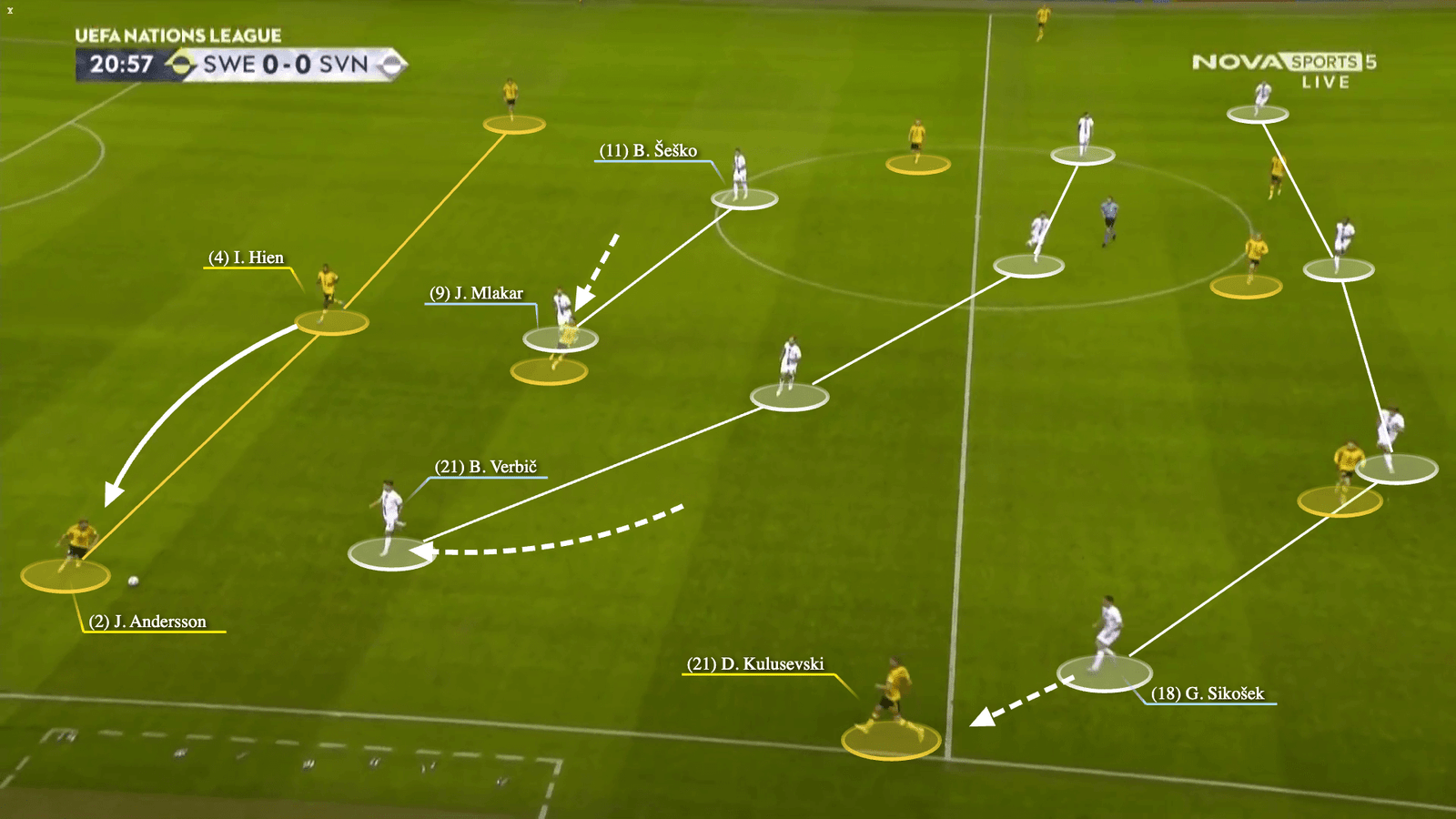Sign up for The Athletic today with our limited-time Tournament Sale offer
Welcome to your third Euro 2024 group guide: Group C.
To help you navigate and prepare for the tournament, The Athletic have compiled group guides, containing each team’s tactics, key players, weaknesses, stats and quirks.
Expect screengrabs to show team shapes and tactics board gifs demonstrating attacking rotations and pressing structures. There will be podcast clips and videos embedded for further reading/listening.
Group C features Gareth Southgate’s England, alongside Serbia, Slovenia and Denmark — England beat Denmark in the Euro 2020 semi-final. It is a group of back fives, build-up rotations and high-scoring No 9s.
Serbia
- Manager: Dragan Stojkovic
- Captain: Dusan Tadic
- Qualifying record: P8 W4 D2 L2 GF15 GA9
- Euros debut: 1960 (Runners-up, as Yugoslavia)
- Euro 2020: Failed to qualify
- Average age of squad in qualifying: 28.4
- Most caps in squad: Dusan Tadic (108)
- Top scorer in squad: Aleksandar Mitrovic (58)
How they play (tactics and formations)
Serbia (formerly part of Yugoslavia) are at their first Euros as a nation-state, after gaining independence in 2006. Head coach Dragan Stojkovic, whose contract ends after the tournament, has said qualifying from the group “would be a success”.
Those who watched them at the 2022 World Cup can expect the same setup: a back five, wing-backs and two defensive midfielders, but either two No 10s and a lone No 9 or one No 10 behind a front two.
Their attacking style is mixed, with a 62 per cent possession average in qualifying — about the same as England and Italy. Against better opposition, though, their strengths are playing direct. Aleksandar Mitrovic is the main focal point but likes to drop in, and is paired with off-the-shoulder Dusan Vlahovic or Luka Jovic.
Serbia’s strikers
| Pairing | Minutes together | Combined goals |
|---|---|---|
|
912 |
23 |
|
|
560 |
16 |
|
|
341 |
12 |
Crosses are Serbia’s main route to goal, especially down the left and particularly from the wing-backs. They had the most headed shots in Euros qualifying, while only Spain and Portugal (seven each) had more headed goals than Serbia’s five. Look out for up-back-through attacking combinations to find the No 10 by playing into the No 9, and then releasing the wing-back.
Against a mid-block, Serbia pull one of the defensive midfielders out to create a makeshift back four, pushing the outside centre-back to the touchline and the wing-back upfield — this allows them to overload the last line.


In attack, they can be devastating. Serbia have scored in 33 out of 39 Stojkovic’s games and have scored three or more on 13 occasions. They won their 2022 Nations League group featuring Norway, Slovenia (also in this Euros group) and Sweden, with the best attack of any League B team (13 goals in six games). No wonder Stojkovic has labelled his team a “golden generation”.
Key player(s)
Mitrovic and Dusan Tadic, even with the pair moving to relatively lower-quality leagues last summer — Mitrovic from Fulham to Saudi Arabia’s Al Hilal, and Tadic from Ajax in the Netherlands to Turkey’s Fenerbahce.
Mitrovic’s international record speaks for itself: 58 goals in 91 caps, with 12 braces and three hat-tricks. When he is on it, Mitrovic is hard to stop, especially for opponents who struggle to defend aerial balls into the box.

Tadic, now 35, still puts up outstanding creative numbers. Only four players bettered his four assists in qualifying, and Serbia’s attack — particularly from central spaces — gains another gear entirely when the No 10 is on the field. He has every final pass in the book: through balls to lock-pick defences, crosses from either side for the No 9s, cutbacks and one-twos to connect with the wing-backs.

Dusan Tadic is still a key player — even at 35 (Srdjan Stevanovic/Getty Images)
What’s their weakness?
Conceding goals. Serbia have only kept four clean sheets in 15 games since the World Cup, particularly problematic as Serbia have only played two teams ranked in FIFA’s top 20 (USA and Belgium) in that time. Impressively, Serbia have only had three losses by two or more goals under Stojkovic, but this owes more to their attack than a watertight defence.
Behind Costa Rica, Serbia had the second-worst 2022 World Cup group-stage defence. They faced 50 shots worth 7.6 expected goals and conceded eight times. It cost them qualification, drawing against Cameroon and losing against Switzerland despite leading in both matches. “At this level there are no excuses. We had the talent to score goals, but it’s often not just about talent, but about organisation,” said Tadic.

Their porousness owes to build-up errors against a high press (see their friendly against Belgium in March) but mainly aggressive use of wing-backs defensively. Rather than keeping a flat back five, Serbia jump their wing-backs to opposition No 8s/No 10s, vacating space in behind and pulling centre-backs wide to cover against wingers.
When Serbia press, they push the wing-backs up to press from a 3-4-3. It often leaves them three-v-three on halfway, reliant on their defenders to win duels.

One thing to watch for
The Tadic-Mitrovic combination. One has assisted the other 21 times (unsurprisingly, 19 have been Tadic to Mitrovic) in 76 caps together. This included three goals in Euros qualification and one against Switzerland at the World Cup. No prizes for guessing the goal method — an early, near-post cross for a glancing header.
𝑭𝒐𝒓 𝒄𝒍𝒖𝒃 𝒂𝒏𝒅 𝒄𝒐𝒖𝒏𝒕𝒓𝒚. 💥
Mitro knows how to put them in the net! 🇷🇸@FSSrbije | #FIFAWorldCup
— FIFA World Cup (@FIFAWorldCup) August 28, 2023
England
- Manager: Gareth Southgate
- Captain: Harry Kane
- Qualifying record: P8 W6 D2 L0 GF22 GA4
- Euros debut: 1968 (Third-place)
- Euro 2020: Runners-up
- Average age of squad in qualifying: 27.9
- Most caps in squad: Harry Kane (91)
- Top scorer in squad: Harry Kane (63)
How they play (tactics and formations)
Three major tournaments for England under Gareth Southgate: one quarter-final finish (World Cup 2022), one semi-final (World Cup 2018) and one final (Euro 2020). They have gone incredibly close and vanquished certain national demons but do not yet have silverware to show for it.
Southgate has evolved England into a style more like 2008-2012 Spain than the England teams of the same era. “We’ve been more dominant in the games we’ve played. We have had complete control in pretty much every match,” said Southgate at the end of 2023.

England showed at World Cup 2022 that they no longer needed to system switch against bigger nations. They continued with the 4-3-3 in the quarter-finals against France, rather than going to the 3-4-3. Jude Bellingham’s exceptional development means a 4-2-3-1, with him the No 10, ought to be plan A in Germany.
Though a back four on paper, right-back Kyle Walker tucked round in build-up in knockout games in Qatar. This provided cover against the pacy Ismaila Sarr and, more importantly, Kylian Mbappe, when England played Senegal and France.

England turning their 4-3-3 into a 3-2-5 attacking shape is synonymous with how most top Premier League sides attack. Southgate has said they are “looking at creative solutions”, having trialled Trent Alexander-Arnold in midfield and Rico Lewis in a hybrid full-back/midfield role. Expect to see short buildup with central midfield rotations to push a full-back upfield.


Southgate and England have not got the credit they deserve for such a composed qualification campaign. They were unbeaten in their first 10 games post-World Cup, with a first win in Italy since 1961, before they lost 1-0 to Brazil at Wembley in March. It meant they went unbeaten in 2023, their first calendar year without defeat since 2011.
Southgate has stressed the importance of “adaptability”, individually and collectively. England can expect back fives and mid/low-blocks in the groups, but will need to win midfield battles and show their defensive side against better teams in the knockout stages.
While the discussion will no doubt fixate on England’s attacking options, their defensive record has been excellent up to now. At the past two tournaments, England kept more clean sheets (eight) than goals conceded (six) in 12 games, and only allowed four goals against in eight Euros qualifying matches. Only Argentina (39) bettered England’s final-third regains at the World Cup (34). Even so, the absence of Harry Maguire through injury, and the lack of clarity about when Luke Shaw will be fit, means England head into Euro 2024 with more defensive questions than many expected.

Key player(s)
Harry Kane. Responsible for 12 goals and three assists at the last three major tournaments, he has been directly involved in over 40 per cent of England’s goals. Italy’s then head coach Roberto Mancini described Kane as the “complete striker” when England won in Naples in March 2023.
His creative side has grown internationally, suited to supplying England’s plethora of dribblers out wide (Bukayo Saka, Anthony Gordon, Jarrod Bowen) or as No 10s (Jude Bellingham, Phil Foden). Kane (eight goals) was fourth top scorer in qualifying and is on his best penalty streak of his career — since missing in the quarter-finals against France, he has scored all 15, including four for England. Oh, and 2023-24 was his best-ever scoring season (36, including five penalties).

What’s their weakness?
Positionally, left-back. Shaw, “physically vulnerable” in Southgate’s words, is the only natural left-back and enters the tournament injured. England’s results with a right-footer (Kieran Trippier) at left-back are better than one might expect, but they do lose an attacking dimension and might need to shuffle their right side to compensate creatively.
Collectively, defending counter-attacks. England’s ambition to dominate games against even the best means their counter-press has to be spot on. Southgate said it was “exceptional” in the 3-1 win away to Scotland, but it was not in the Wembley defeat against Brazil. England’s high line gave too much space for Brazil’s front three to run in behind, and they duly conceded their most big chances (seven) in any game under Southgate.
One thing to watch for
Goals in the final 15 minutes before half-time. England have shown remarkable consistency in wearing teams down with possession. They scored five without conceding between 30 and 45 minutes at the World Cup, the joint-most with Argentina. It was also England’s best 15-minute period of the game in qualification for that World Cup (nine/39 goals) and this Euros (eight/22 goals).

Denmark
- Manager: Kasper Hjulmand
- Captain: Christian Eriksen
- Qualifying record: P10 W7 D1 L2 GF19 GA10
- Euros debut: 1964 (Fourth-place)
- Euro 2020: Semi-finals
- Average age of squad in qualifying: 28.5
- Most caps in squad: Simon Kjaer (132)
- Top scorer in squad: Christian Eriksen (41)
How they play (tactics and formations)
Euro 2022 and World Cup 2022 went entirely differently for Denmark. At the last Euros, they made the semi-finals for the first time since they won the tournament in 1992. Their cross-heavy 3-4-3 was awkward to defend against, especially right-footed left wing-back Joachim Maehle.

But they flattered to deceive in Qatar. Head coach Kasper Hjulmand was consistent in his pre-tournament message, wanting to evolve beyond “underdog” football to “be proactive, dominate as much as possible, go for goals”. Tunisia cancelled out their shape in the first game (0-0) and, after losing to France (2-1) on matchday two, they switched to a 4-3-3 for the final match versus Australia.
Denmark lacked incision. Their switches to Maehle were as predictable as defendable. Australia won 1-0 with a counter-attack goal. We “haven’t played with the tempo and the rhythm,” said Hjulmand afterwards, adding that “the structures just go out of the match”. It was the only time in Hjulmand’s tenure (50 games) that Denmark have gone three games without a win.

The numbers made for stark reading: No wins and only one goal scored, from a set piece; the only team to not complete a through ball; the most switches of play per game; the lowest dribble success rate.
Against inferior teams in Euros qualification, Denmark stuck with the 4-3-3, but played a 3-4-3 in both games against Slovenia, their strongest opposition. It gives a stronger defensive base, settling into a 5-4-1 or 5-3-2, and gets midfielders closer to support Maehle, who has played off the right too.

Christian Eriksen and Pierre-Emile Hojbjerg are the first-choice midfield partnership, balancing a passer with a ball-winner. This means Hjulmand can be creative with his front three, mixing between playing a front two with one No 10, or a lone striker and two No 10s.
Expect switches of play, especially to Maehle, from Crystal Palace’s Joachim Andersen (one of five Palace players in Group C), who plays right centre-back. There will be penetrative runs from No 8s against a low block and plenty of early crosses and cutbacks — the wing-back and midfielders like to crash the box.

Key player(s)
The quality of Eriksen and Maehle is known, with Hjulmand saying Eriksen is the “best player in Denmark”. Their success at this Euros will depend on the performances of and service to Rasmus Hojlund.
Denmark’s recent issue with No 9s has been a wild variety of profiles (Jonas Wind, Martin Brathwaite, Yussuf Poulsen) and the lack of a consistent scorer. Maehle is the only player with 10+ goals under Hjulmand, and he used a different striker in each World Cup game.
Pressure, then, on Hojlund, who only made his senior debut in late 2022 and was not part of the World Cup squad. He has settled into senior international football fantastically, with seven goals in 14 caps. All of those were in qualifying and, while he has not scored in four friendly appearances since, Hojlund’s goal-scoring variety is promising: a mix of one-touch finishes from crosses/cutbacks — which Hojlund throws himself at — and angled finishes, similar to his penalty-box-based debut season at Manchester United.

What’s their weakness?
Denmark are not a strong team from losing positions, which speaks to a lack of a plan B — they might change shape but their tactics remain the same. They have lost five of their last six when conceding first, not coming from behind since they won 2-1 in France in March 2022.
Aside from Hojlund (who is likely to start), they lack a goalscorer from the bench and Denmark have not had many tactical acid tests. They were the only top 50-ranked FIFA team in their qualifying group and Hjulmand’s side have only played one team ranked higher than them (Switzerland in a 0-0 friendly draw in March) since the 2022 World Cup.
One thing to watch for
Straight corners. They played eight of these at the World Cup (from a total of 21) and nine at Euro 2020 (of 39), the most of any team at either tournament. With Eriksen’s delivery, Hojlund’s height plus three centre-backs, Denmark are stacked with set-piece quality.
Slovenia
- Manager: Matjaz Kek
- Captain: Jan Oblak
- Qualifying record: P10 W7 D1 L2 GF20 GA9
- Euros debut: 2000 (Group stage)
- Euro 2020: Failed to qualify
- Average age of squad in qualifying: 27.1
- Most caps in squad: Jasmin Kurtic (91)
- Top scorer in squad: Josip Ilicic (17)
How they play (tactics and formations)
Slovenia are back, at their first major tournament since the 2010 World Cup. At a glance, not a lot looks to have changed. Matjaz Kek managed them in South Africa in 2010 and is in his second stint as national team boss, having returned in November 2018. They play a 4-4-2, as they did then, though none of the 2010 squad remain.
It is a team built on structure: “I like to give players freedom, but I demand their full responsibility,” said Kek ahead of the March friendly win (2-0) at home to Portugal. “We must be able to suffer defensively, but we must also think about when we have the ball. We cannot just wait in a block,” he added.
The switch to 4-4-2 came at the end of the 2022 Nations League, when they finished third in a group featuring Sweden, Serbia and Norway, having initially played a back three. In the 19 games since the system switch, Slovenia have 13 wins, four draws and only two defeats, outscoring opponents 34-16 and keeping seven clean sheets. That form meant 2023 was their best calendar year ever for wins (seven, from 10 games) and goals-per-game (two).
Their style is devoutly risk-averse. They set up to press high at opposition goal-kicks but quickly retreat to a 4-4-2 mid-block.


When building up, expect to see the first pass or two short, but under pressure they play long to the front two, looking for flick-ons and second balls. They like wide combinations, especially one-twos, but rotations are minimal. A central midfielder occasionally plays between the centre-backs, though a common tactic is rolling the ball-side winger infield to act as an auxiliary No 8 in support of the No 9.

Slovenia are stubborn to build up against, pressing aggressively when teams pass into midfield. Of teams to make the finals, only Georgia (109) made more tackles in qualifying (Slovenia made 91).
They force teams round and into crossing. Despite Slovenia playing a back four and theoretically being vulnerable to a front-five overload against wing-back systems, they make aggressive winger and full-back pressing jumps against a back-five. This forces the outside centre-back to pass long and pins the wing-back.


Slovenia are dangerous on counter-attacks, especially as they leave their front two up when defending deep. Expect to see launched passes or dribbles from midfielders. They have repeatedly scored from opposition goal kicks too, when they punt upfield and Slovenia win the aerial duel, then quickly play in behind the high line.
Their opener at home to Portugal was a classic counter-attack, going end-to-end in 13 seconds and five passes. Second-best was Benjamin Sesko’s second goal in the 2-0 qualifying win at home to Finland. Fittingly, they sealed their place in Germany by beating Kazakhstan at home, with the winning goal coming from a counter-attack.
Slovenia might be the weakest team in the group but they keep games tight. Sixteen of their 26 wins under Kek have been by one goal, with eight of 12 losses by a single goal. In many ways, they play an ideal, disciplined tournament style — they only received 10 yellow cards in 10 qualifying games, the fewest of any nation going to Germany, and qualified automatically for the first time ever.
Key player(s)
Goalkeeper and national team captain Jan Oblak gets his “fulfilment of a childhood dream”. He made his international debut back in late 2012 but will finally represent Slovenia in a major tournament. The Atletico Madrid goalkeeper’s shot-stopping has dipped in recent years, admittedly from one of the world’s best to closer to average, but his international record is solid: Oblak has 30 clean sheets and only 53 goals conceded in 64 caps.

At the other end, Slovenia have another match-winner in Sesko. He has just turned 21, but at 6ft 4in (193cm) provides a phenomenal profile and has had an excellent debut season at RB Leipzig. “He is physically strong, technically gifted and mature,” said Kek on Sesko in 2023. “There aren’t many strikers like this in the world. I think he has steadily improved, becoming more concrete in his decisions.”

Sesko brings a lot in build-up, able to take aerial balls and bring midfielders into play, as well as chase channels. Most importantly, though, he scores goals — every type you can imagine, and at an excellent rate.
Sesko, Slovenia’s youngest player and youngest goalscorer, has 11 goals in 29 caps. There is every chance he wins the goal of the tournament, with an eye for an outrageous finish — check his volleys against Sweden and Norway in the 2022 Nations League, one scored with either foot.
What’s their weakness?
Individually, a lack of major tournament experience — none of these players have featured at a Euros or World Cup before. There is a lack of depth, with only four players in Europe’s top five leagues. Slovenia need their individuals at both ends to shine. “They have the privilege to rotate, we do not,” said Kek ahead of the Portugal friendly in March. “We must take advantage of everything we have.“
One thing to watch for
Josip Ilicic, now 36, has been recalled by Kek for the tournament despite not playing international football since November 2021. He is the joint-fifth-most capped player in Slovenia’s history (91), with Samir Handanovic, and third top-scorer. Ilicic scored Slovenia’s winner in a friendly against Armenia in early June, his first international goal since November 2021.
Ilicic was released by Atalanta at the end of 2021-22, after five seasons there, now playing for NK Maribor in Slovenia’s top flight. A versatile forward, most likely to play a wide midfield role, given the established front two of Sesko and Andraz Sporar (they started six out of 10 qualifiers together). Atalanta head coach Gianpiero Gasperini once said that Ilicic was “worthy of the Ballon d’Or”. He has a chance for a fairytale career ending.
Fixtures
Round 1:
- 16/06/2024 — Slovenia vs Denmark (5pm BST, 6pm CEST, 12pm EDT)
- 16/06/2024 — Serbia vs England (8pm BST, 9pm CEST, 3pm EDT)
Round 2:
- 20/06/2024 — Slovenia vs Serbia (2pm BST, 3pm CEST, 9am EDT)
- 20/06/2024 — Denmark vs England (5pm BST, 6pm CEST, 12pm EDT)
Round 3:
- 25/06/2024 — England vs Slovenia (8pm BST, 9pm CEST, 3pm EDT)
- 25/06/2024 — Denmark vs Slovenia (8pm BST, 9pm CEST, 3pm EDT)
(Top photo: Getty Images; design: Eamonn Dalton)
Read the full article here


